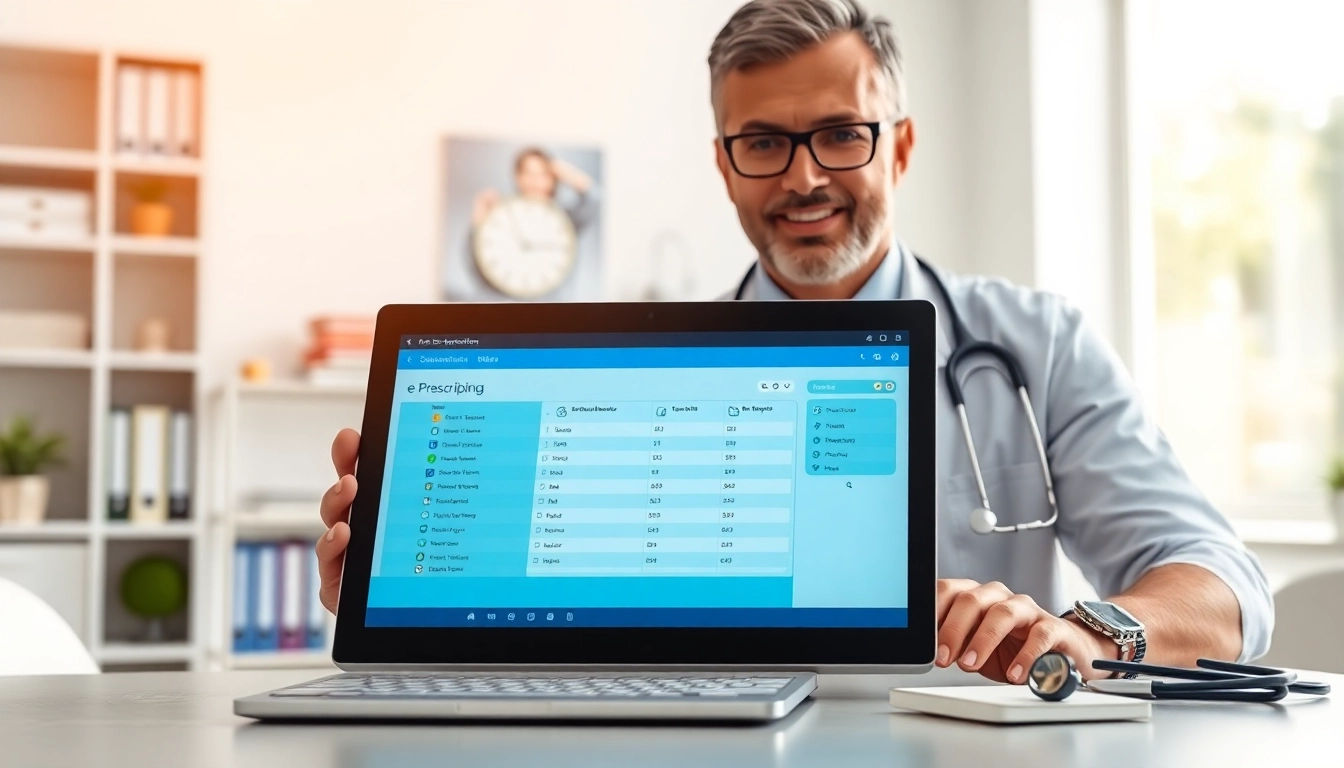Understanding ePrescribing Platforms
In the ever-evolving landscape of healthcare, eprescribing platforms have emerged as vital tools, enabling healthcare providers to enhance the efficiency and accuracy of prescription processing. These digital systems streamline the prescription workflow, allowing for a seamless connection between prescribers, pharmacies, and patients. In this detailed exploration, we will delve into the intricacies of ePrescribing platforms, discussing their key features, benefits, and the essential considerations when choosing the right platform for your healthcare practice.
What are ePrescribing Platforms?
ePrescribing platforms are software solutions designed to facilitate the electronic creation, management, and transmission of prescription orders from healthcare providers to pharmacies. This method eliminates the traditional paper-based prescription process, which is often fraught with communication errors, delays, and logistical challenges. Essentially, ePrescribing represents a significant advancement in digital health, integrating directly with electronic health record (EHR) systems to ensure that prescriptions are accurate and efficiently handled.
Key Features of Effective ePrescribing Platforms
A robust ePrescribing platform boasts several essential features that enhance its utility for healthcare providers. These include:
- Integrated EHR Compatibility: The ability to synchronize seamlessly with existing EHR systems, allowing for a unified workflow.
- Medication History Access: Real-time access to patient medication histories to prevent adverse drug interactions and ensure prescribing accuracy.
- Automated Alerts: Features that provide alerts for potential drug interactions, allergies, and formulary changes.
- Prescription Tracking: Systems that enable tracking of prescriptions from issuance to fulfillment, helping to monitor patient adherence.
- User-Friendly Interface: An intuitive design that simplifies the prescription process for healthcare providers.
Benefits of Implementing ePrescribing Platforms
The adoption of ePrescribing platforms offers numerous advantages brought forth by technology. Key benefits include:
- Enhanced Accuracy: Reducing errors associated with handwriting and miscommunication that often occur with paper prescriptions.
- Time Efficiency: Streamlining the prescribing process saves time for both prescribers and pharmacists, facilitating quicker patient care.
- Improved Patient Safety: Access to real-time medication information helps in prescribing safer treatments for patients.
- Increased Compliance: E-prescribing encourages adherence to regulatory requirements by documenting prescriptions electronically.
- Cost Reduction: By minimizing errors and improving efficiency, ePrescribing can significantly lower administrative costs for healthcare facilities.
Choosing the Right ePrescribing Platforms
Selecting the appropriate ePrescribing platform is crucial to maximizing its benefits within your healthcare practice. The right choice can improve workflows, enhance patient care, and ensure compliance with regulations.
Factors to Consider When Selecting ePrescribing Platforms
When evaluating ePrescribing platforms, consider the following factors:
- Cost: Assess the pricing structure of the platform, including any subscription fees, transaction costs, and hidden charges.
- Integration: Ensure that the platform integrates smoothly with your current EHR and other practice management systems.
- Scalability: Choose a platform capable of scaling as your practice grows, accommodating additional features and user access as needed.
- Customer Support: Consider the availability and quality of support services offered by the platform provider.
- User Experience: Evaluate the platform’s user interface and ensure it is intuitive and easy to navigate for both clinicians and staff.
Comparing Popular ePrescribing Platforms
With numerous ePrescribing solutions available in the market, comparing different platforms based on features, user experience, and reviews can help in making an informed decision. Look into platforms that are widely adopted in the industry and have demonstrated success in improving prescription processes. Pay attention to user feedback and case studies to understand real-world applications and outcomes of the software.
Integration Capabilities with EHR Systems
Integration with EHR systems is a critical element of ePrescribing platforms. A well-integrated system allows for easy sharing of patient information, ensuring that prescribers have access to complete medical histories and that prescriptions are transmitted effectively. When selecting ePrescribing software, prioritize those that offer robust integration capabilities with popular EHR systems in your healthcare setting.
Optimizing Workflow with ePrescribing Platforms
ePrescribing platforms can significantly optimize clinical workflows, leading to improved patient outcomes and operational efficiencies.
Improving Prescription Accuracy and Communication
Accurate prescription writing is fundamental in healthcare. ePrescribing platforms enhance accuracy by leveraging digital documentation to eliminate human error. Integrated medication databases help prescribers check for past prescriptions, allergies, and drug interactions instantly, reducing the likelihood of adverse events. Furthermore, effective communication tools within ePrescribing platforms facilitate clearer interactions among healthcare providers, pharmacists, and patients.
Streamlining Patient Engagement through ePrescribing Platforms
Engaging patients in their care is crucial for effective treatment. ePrescribing platforms can enhance patient engagement by allowing patients to manage their prescriptions through patient portals or mobile apps. Patients can receive notifications when their prescriptions are ready, access information about their medications, and communicate with providers about any concerns, thus fostering a collaborative healthcare environment.
Monitoring and Managing Prescription Processes
ePrescribing platforms provide tools for monitoring the prescription process, allowing healthcare providers to track the status of medications from prescription issuance to dispensation. Automated reminders for refill requests and medication reviews can enhance patient adherence, while comprehensive reporting features can help practices identify trends, such as medication adherence rates and prescription errors, facilitating continuous improvement in care delivery.
Regulatory Compliance and Security in ePrescribing Platforms
Healthcare providers must navigate a complex regulatory landscape when implementing ePrescribing solutions. Understanding compliance and security is essential for safeguarding patient information.
HIPAA Regulations and ePrescribing
The Health Insurance Portability and Accountability Act (HIPAA) outlines stringent requirements for protecting patient information. ePrescribing platforms must comply with HIPAA by implementing necessary security measures, ensuring that patient data remains confidential and secure during transmission. Compliance with these regulations not only protects patient information but also mitigates legal risks associated with data breaches.
Ensuring Data Security in ePrescribing Platforms
Data security is paramount in ePrescribing. Secure platforms utilize encryption techniques to protect patient data, both at rest and during transmission. Authentication mechanisms also play a critical role in ensuring that only authorized personnel can access sensitive information. Additionally, regular security audits and risk assessments can help identify potential vulnerabilities within the platform.
Updating Compliance Procedures Regularly
As regulatory requirements evolve, keeping compliance procedures updated is essential. Healthcare organizations should establish guidelines for regularly reviewing and updating their ePrescribing systems to incorporate any changes in regulations or security standards. Staff training on compliance measures should also be conducted periodically to reinforce the importance of data security and patient confidentiality.
Case Studies and Outcomes of ePrescribing Platforms
Real-world applications and outcomes provide valuable insights into the effectiveness of ePrescribing platforms. Analyzing success stories can inspire healthcare providers to implement or optimize these systems.
Success Stories from Healthcare Providers
Numerous healthcare providers have reported significant improvements in their prescription processes after implementing ePrescribing platforms. These success stories often highlight enhanced medication management, reduced prescription errors, and greater patient satisfaction. For example, facilities that have adopted ePrescribing report decreases in wait times for patients and a rise in prescription accuracy, leading to overall better healthcare delivery.
Measuring the Impact of ePrescribing Platforms on Patient Care
To quantify the effectiveness of ePrescribing systems, healthcare organizations should utilize key performance indicators (KPIs). Metrics such as prescription error rates, refill adherence, and patient waiting times offer valuable insights into how ePrescribing impacts patient care. Regular analysis of these metrics allows practices to adapt and refine their approach to electronic prescribing, optimizing their overall effectiveness.
Future Trends in ePrescribing Platforms
As technology continues to evolve, so too will ePrescribing platforms. Future trends may include artificial intelligence-driven features to enhance prescriber decision-making, further integration with telehealth solutions, and advances in user interface design for improved accessibility. These innovations hold great potential for transforming how healthcare providers manage prescriptions and interact with patients, ensuring that ePrescribing remains at the forefront of healthcare technology.



